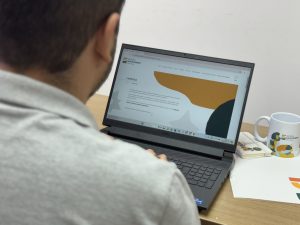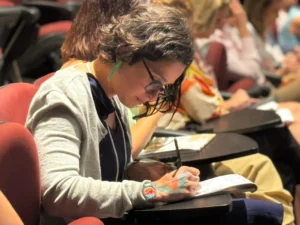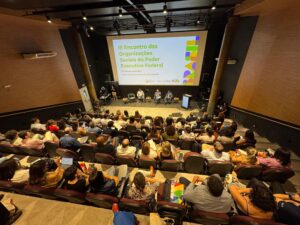Popularly known as open spine disease, spina bifida is the health condition that affects the majority of babies, children and adolescents with spinal cord injuries treated at the Specialized Rehabilitation Center of the Santos Dumont Institute (ISD), in Macaíba. Next Monday, October 25th, ISD and the Neurinho Association will carry out activities in honor of International Spina Bifida and Hydrocephalus Day in the Paulo Freire Auditorium, at the Anita Garibaldi Health Research Education Center (Anita). Today, there are 73 patients undergoing multidisciplinary follow-up at the ISD Children's Spinal Cord Injury Clinic. There is no data on the total or approximate number of people with this disease in Rio Grande do Norte.
According to ISD's multidisciplinary preceptor and physiotherapist, Camila Simão, spina bifida is a congenital spinal cord injury that causes malformation in the vertebral arches that protect the spinal cord, creating a kind of “pocket” outside the spine that varies in height depending on each case. and, therefore, cause motor and sensory injuries, in addition to neurogenic bladder and intestines. “Depending on the height of the injury, the child will have greater or lesser functional impairment, depending on the motor and sensory function that will be preserved, for example. It is a malformation that is commonly associated with hydrocephalus. October 25th is an awareness day. Spina bifida is the most prevalent health condition involving spinal cord injury in children and adolescents treated at ISD”, comments Camila Simão.
At the event, issues raised by patients and families treated at the ISD Children's Spinal Cord Injury Clinic will be discussed, formed by a multidisciplinary team made up of, in addition to physiotherapist Camila Simão, multidisciplinary neuropsychology preceptors Artemis de Paula; in occupational therapy, Thays Machado; in psychology, Marta Raquel Alves; in speech therapy, Marília Pinheiro; by Anita’s manager, physiotherapist Lilian Lira Lisboa; by the medical preceptors in orthopedics, Kalyana Fernandes; in Neurosurgery Ângelo Raimundo; and, in urology, Rafael Pauletti Gonçalves. “Based on the demand brought to us by Neurinho associates and also based on the needs of our users, we will hold a discussion around neurogenic bladder and intestine”, says Camila Simão.
For Neurinho, Joelma Neuma Dos Prazeres da Silva, Edmilson Firmino da Silva, Juliana Andrade de Castro Oliveira, Nelycelia Araújo, Eugênio Siqueira de Melo, Renata Bezerra dos Santos Costa, Maria da Conceição Matos dos Santos de Azevedo and Teotônia Manuela Ferreira De will participate. Lime. “It will be a time to bring parents and children together to discuss important issues. For all of us, it is an interesting moment”, comments Juliana Oliveira, from the management of Neurinho. Neurinho is a non-profit association that emerged at the encouragement of neurosurgeon Dr. Mércia Jeanne Duarte Bezerra with the aim of supporting children with myelomeningocele and their families in special care for this pathology, also counting on the support of the team at the Hospital de Pediatria da Universidade Federal from Rio Grande do Norte (Hosted/UFRN).
What is spina bifida
Spina bifida is known as a neural tube defect. It occurs during development before birth. This is when the spinal cord, brain or meninges (their protective covering) do not fully develop. It can be anywhere along the spine and can usually be seen in an opening in the baby's back at birth. It may also appear as a sac of fluid that has grown outside the body on the spine. This sac may or may not include the spinal cord inside.
There are three types of spina bifida: myelomeningocele, meningocele, and spina bifida occulta.
Myelomeningocele
This is the most common and serious type of spina bifida. It involves a sac outside the opening in the baby's back somewhere on the spine. This sac contains parts of the spinal cord and nerves. The spinal cord and nerves in the sac will be damaged.
People with myelomeningocele have physical disabilities that range from moderate to severe. These disabilities may include: incontinence, difficulty going to the bathroom, inability to move or feel your legs or feet.
Meningocele
This type of spina bifida also involves a sac of fluid outside an opening in the baby's back. However, the sac does not contain any part of the spinal cord. Since there is not much damage to the nerves, meningocele causes only minor disabilities.
Spina bifida occulta
This is a mild type of spina bifida. It can also go by the term “occult” spina bifida. It does not cause any disabilities and may go unnoticed until later in life. There is usually no opening in the baby's back, but just a gap in the spine. In this type, there is no damage to the spinal cord or nerves.
Main causes
All the exact causes of spina bifida are not specifically understood. It is known that it involves a combination of genetic and environmental factors. However, a child born with spina bifida may not have relatives with this condition, even though genetics are an important factor. It is also believed that a lack of folic acid, also known as vitamin B-9, can influence the condition. Other factors believed to play a role include: obesity, diabetes in the mother that is not well controlled during pregnancy, and some medications.
Source: Pan American Health Organization (PAHO)
Text: Ricardo Araújo / Ascom – ISD
Photograph: PAHO
Communication Office
comunicacao@isd.org.br
(84) 99416-1880
Santos Dumont Institute (ISD)
It is a Social Organization linked to the Ministry of Education (MEC) and includes the Edmond and Lily Safra International Institute of Neurosciences and the Anita Garibaldi Health Education and Research Center, both in Macaíba. ISD's mission is to promote education for life, forming citizens through integrated teaching, research and extension actions, in addition to contributing to a fairer and more humane transformation of Brazilian social reality.













